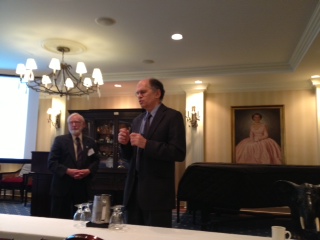By Kitta MacPherson
WASHINGTON, D.C. – What happens when the forces of fusion
gather?
At the annual meeting of the Fusion Power Associates, held
at the tony Capitol Hill Club in the shadow of the U.S. Capitol, there’s lots
of talk about “plasmas” and “hohlraums” and of devices called stellarators and other
machines with names like “Z.”
Starting yesterday and continuing through today, the leaders
of fusion energy research in the U.S. from U.S. Department of Energy-funded
laboratories, as well as from industry and publicly funded university programs, have been and will continue to
line up and present, in rigorously timed 20-minute-long segments, the state of
their art. Differences in approaches to
fusion from inertial confinement where pellets are zapped by lasers to magnetic
confinement where a superhot gas is corked in a magnetic bottle are described.
As competitive as the programs may be, all are regarded here as being under the
aegis of fusion--part of the ecumenical approach of Steve Dean, the founder and
executive director of the sponsoring group, the Fusion Power Associates.
The purpose of FPA, a non-profit foundation based in
Gaithersburg, Md., is, according to its website, to “ensure the timely
development and acceptance of fusion as a socially, environmentally, and
economically attractive source of energy.” The meetings are designed to
showcase management-level scientists and their technical achievements.
In the long narrow, federal style Eisenhower Room,
an observer in the space of several minutes can
hear a full range of approaches to fusion from some of its best minds.
Attendees can hear Mike Dunne, a leading scientist at the National
Ignition Facility based at
Lawrence Livermore National Laboratory in California, describe
scientific
advances in inertial fusion at the facility, pointing to diagrams
showing
cylindrical capsules called “hohlraums” that hold fusion fuel capsules.
One can
then listen to Stewart Prager, director of the Princeton Plasma Physics
Laboratory, convey elements of progress in magnetic fusion. The
Princeton lab is
focusing on areas with breakthrough potential where the U.S. can lead,
he said.
And lest anyone think that PPPL is overly focused on a doughnut-shaped
fusion reactor configuration known as a tokamak, Prager indicated his
commitment to also support
another configuration known as a stellarator. “We believe that
stellarators are
not a luxury item, we believe they are essential for fusion,” he said.
Observers at the meeting also can get a taste of the
international.
Ned Sauthoff, director of the U.S. ITER program, talked
about the importance of scientific research being conducted now to benefit
ITER, a mammoth experimental fusion vessel under construction in Cadarache,
France. “The science of ITER is happening now,” he said. “In order for it to
succeed, you have to have a strong program that is related to things like
burning plasmas.” The goal of ITER is to achieve 500 megawatts of fusion power.
The giant tokamak is being designed to demonstrate the scientific and
technological feasibility and safety features of fusion energy, Sauthoff said.
Tight budgets for domestic programs have leaders such as Miklos
Porkolab, director of MIT’s Plasma Science Fusion Center, expressing concerns.
“Vigorous research in the next decade is necessary on existing tokamak
facilities with upgrades in heating and current drive power as well as advanced
plasma diagnostics and tungsten plasma-facing components,” he said, adding that
much physics remains to be explored on existing tokamaks in order to optimize
ITER’s operation. The largest U.S. experimental magnetic fusion devices--at
MIT, PPPL, and General Atomics--are complementary, he noted, and need sustained
support.
In his presentation on fusion experiments at Los Alamos
National Laboratory, Glen Wurden said he is worried about the impact
of cuts to the domestic fusion program, especially in light of growing ITER
commitments, and the survivability of the U.S. plasma physics and fusion research
enterprise should there be additional cuts in future years. “We are dangerously
approaching the tipping point,” he said.
Mark Herrmann, a physicist at Sandia National Laboratory,
who was recognized for his research with an award from FPA, spoke with
excitement about his work on a 10,000 square-foot experimental fusion device
known as “Z”. “You have to be an optimist to be a fusion scientist,” he said
with a smile.

No comments:
Post a Comment